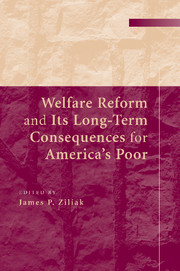Book contents
- Frontmatter
- Contents
- Contributors
- Preface
- Introduction
- 1 What We Know, What We Don't Know, and What We Need to Know about Welfare Reform
- 2 Welfare Reform and the Level and Composition of Income
- 3 How Have Expansions in the Earned Income Tax Credit Affected Family Expenditures?
- 4 How Families Are Doing Nine Years after Welfare Reform: 2005 Evidence from the Three-City Study
- 5 The Impact of Welfare Reform on Leaver Characteristics, Employment, and Recidivism
- 6 A Reexamination of the Impact of Welfare Reform on Health Insurance Among Less-Skilled Women
- 7 How Welfare Policies Affect Child and Adolescent School Performance: Investigating Pathways of Influence with Experimental Data
- 8 The Effects of Welfare and Child Support Policies on the Incidence of Marriage Following a Nonmarital Birth
- 9 Welfare Reform and Health among the Children of Immigrants
- 10 Mismatches and Unmet Need: Access to Social Services in Urban and Rural America
- Index
5 - The Impact of Welfare Reform on Leaver Characteristics, Employment, and Recidivism
Published online by Cambridge University Press: 21 January 2010
- Frontmatter
- Contents
- Contributors
- Preface
- Introduction
- 1 What We Know, What We Don't Know, and What We Need to Know about Welfare Reform
- 2 Welfare Reform and the Level and Composition of Income
- 3 How Have Expansions in the Earned Income Tax Credit Affected Family Expenditures?
- 4 How Families Are Doing Nine Years after Welfare Reform: 2005 Evidence from the Three-City Study
- 5 The Impact of Welfare Reform on Leaver Characteristics, Employment, and Recidivism
- 6 A Reexamination of the Impact of Welfare Reform on Health Insurance Among Less-Skilled Women
- 7 How Welfare Policies Affect Child and Adolescent School Performance: Investigating Pathways of Influence with Experimental Data
- 8 The Effects of Welfare and Child Support Policies on the Incidence of Marriage Following a Nonmarital Birth
- 9 Welfare Reform and Health among the Children of Immigrants
- 10 Mismatches and Unmet Need: Access to Social Services in Urban and Rural America
- Index
Summary
Introduction
Welfare reform legislation at both the state and national levels since the mid-1990s has transformed the U.S. cash assistance program for single parents and their children. Among the stated goals of the federal reform legislation was to “end the dependence of needy parents on government benefits by promoting job preparation, work, and marriage.” By 2000, caseloads had declined in every state from peaks in the mid-1990s, with the national caseload declining by more than one-half. Yet, whether these declines represent improvements in the long-run well-being of current and former welfare recipients remains a contentious issue. Research has shown that postreform welfare leavers have low levels of job skills and are working in jobs with low wages, few benefits, and little security.
Reforms to welfare have been associated with substantial increases in the levels of employment for recipients (Department of Health and Human Services 2000). We know that those who leave welfare are likely to be working but that their earnings are often very low and that many of them are suffering substantial hardship (Acs and Loprest 2004; Frogner, Moffitt, and Ribar, Chapter Four this volume; Parrott 1998; Tweedie, Reichert, and O'Connor 1999). In contrast to expectations, it does not appear that reforms have caused welfare caseloads to become more disadvantaged (Moffitt and Stevens 2001), although since the implementation of Temporary Assistance for Needy Families (TANF) the nonwhite proportion has increased substantially (Zedlewski and Anderson 2001).
- Type
- Chapter
- Information
- Welfare Reform and its Long-Term Consequences for America's Poor , pp. 172 - 216Publisher: Cambridge University PressPrint publication year: 2009
- 1
- Cited by



